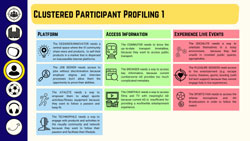
Project
From 2021 to 2022, I worked on TeamPlayer, a research project which investigated how to ease the burdens felt by the visually impaired community.
Our three key aims were:
- Value over Profit: our project should be meaningful to the visually impaired and to us.
- Empathy in Ethics: we should treat the subject with sensitivity, respect, and human focus.
-
Open Working Environment: we will foster clarity, learning and creativity within our group.
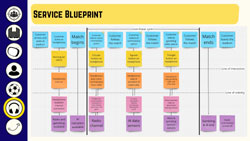
We will evaluate our approach to any concepts that we ideate using these criteria, to create a worthwhile body of work and make the best difference for the VI.
Our research methods includes autoethnographic practices and STEEPLE research. Thanks to Blind Veterans and 4Sight, we arranged interviews with visually impaired participants to discuss the issues they experience. Each interview followed a similar structure around the following questions:
- What forms of entertainment/leisure/exercise do you engage in on your own/with sighted people/with other VIPs?
- What leisure activities do you find the hardest to enjoy?
- What leisure activities haven’t you tried due to inaccessibility?
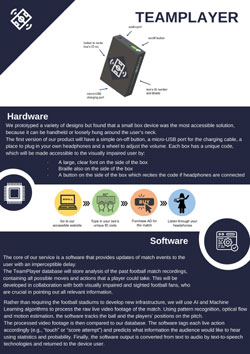
To cluster these insights, we identified 16 different profiles from our interviewees which represented different challenges they faced as VIPs. These specific personas were framed as problem statements that were then clustered into larger trends.
After an interview with the CEO of 4Sight, we were able to narrow our research into one problem statement:
“The visually impaired football fan needs real-time commentary, because they struggle to engage with the live atmosphere and the events of the game.”
While conducting the secondary research around this question, we came across the idea of an AI commentary software which updates the visually impaired of the real-time action on the pitch.
We developed a business plan around the idea. This included our core value proposition, market analysis, operations modelling, financial forecasts and risk analysis. Here are a few highlights from the executive summary:
- TeamPlayer’s mission is to enable VIPs to access and follow the action of live football matches using audio description technology based on established AI tracking software.
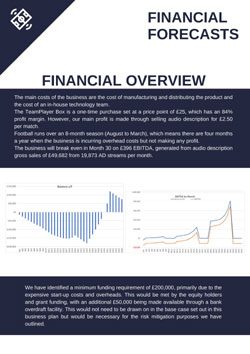 Our focus differentiation strategy gives us first mover advantage in a market where simple radio connections experience a lag against real-time action and limited competitors are currently only offering tactile alternatives to audio description.
Our focus differentiation strategy gives us first mover advantage in a market where simple radio connections experience a lag against real-time action and limited competitors are currently only offering tactile alternatives to audio description.
- Assistive Technologies for the visually impaired was valued at $799.21 Million in 2020 and is projected to reach $1,364.57 million by 2028, growing at a compound annual growth rate (CAGR) of 6.92% from 2021 to 2028 (Assistive Technologies For Visually Impaired Market Size And Forecast, 2022).
- Our services rely on video footage provided by a third-party broadcaster. Our first three years focus on building our customer base within a Sky Partnership, capturing both target consumers for popular men’s football league matches in England and Wales.
- The TeamPlayer Box is a one-time purchase set at a price point of £25, which has an 87% profit margin. However, our main profit is made through selling audio description for £2.50 per match. The business will break even in Month 30 on £396 EBITDA, generated from audio description gross sales of £49,682 from 19,873 AD streams per month.
- We have identified a minimum funding requirement of £200k primarily due to the expensive overheads (£137,268 p.a.).
I learned so much from this project, from an insight into a demographic about whom I had initially known very little, to how to create balance sheets and conduct detailed market analysis.
You can read our progress report and eventual business plan here.
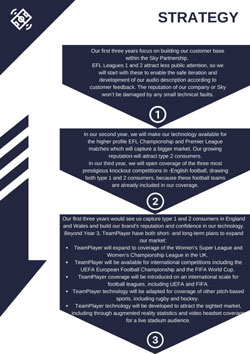
Critical and Reflective Essay
After the project I wrote an essay which drew on my experience of the project to develop both an academic critique of some aspect of the design and venture creation process and a separate reflection that responds to that critique, sharing how my lived experience of this aspect shaped my personal perspective on design and venture creation.
I chose to study Sarasvathy’s dichotomy of causation and effectuation and develop its critical analysis in the context of a novice, start-up environment, such as our project. This is the introduction:
“In her seminal work What Makes Entrepreneurs Entrepreneurial (2005), Sarasvathy creates a dichotomy between causation, the use of means to identify the most efficient method of achieving a pre-determined goal, and its ‘inverse’: effectuation, the use of means to establish contingent goals over time. This has sparked an intense academic debate about the merits of using one approach over the other Chandler et al. argue that we should seek to validate both sides of the debate and therefore this critique will evaluate three of the distinctions Sarasvathy makes between causation and effectuation: prediction vs control logic; novice vs expert; and corporate vs start-up.”
Read the full essay here.